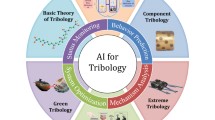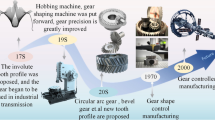Abstract
Based on the configuration principles of biological skeletons and sandwich stems, a machine tool column with stiffening ribs inside was designed using structural bionic method. After the lightening effect was verified by finite element simulation, scale-down models of a conventional column and a bionic column were fabricated and tested. Results indicate that the bionic column can reduce the maximum static displacement by 45.9% with 6.13% mass reduction and its dynamic performances is also better with increases in the first two natural frequencies. The structural bionic design is effective in improving the static and dynamic structural performances of high speed machine tools.
Similar content being viewed by others
References
Smith S, Tlusty J. Current trends in high-speed machining. Journal of Manufacturing Science and Engineering, 1997, 119, 664–666.
Liu J S, Hollaway L. Design optimisation of composite panel structures with stiffening ribs under multiple loading cases. Computers and Structures, 2000, 78, 637–647.
Kim D I,. Jung S C, Lee J E. Parametric study on design of composite-foam-resin concrete sandwich structures for precision machine tool structures. Composite Structures, 2006, 75, 408–414.
Chang S H, Kim P J, Lee D G, Chol J K. Steel-composite hybrid headstock for high-precision grinding machine. Composite Structures, 2001, 53, 1–8.
Lee D G, Chang S H, Kim H S. Damping improvement of machine tool columns with polymer matrix fiber composite material. Composite Structures, 1998, 43, 155–63.
Rahman M, Mansur M A, Feng Z. Design, fabrication and evaluation of a steel fibre reinforced concrete column for grinding machines. Materials & Design, 1995, 4, 205–209.
Zhou B L. Bio-inspired study of structural materials. Materials Science and Engineering, 2000, C11, 13–18.
Cen H T, Wang S, Chen W Y. New development in structural bionics. Journal of machine design, 2003, 11, 1–4. (in Chinese)
Ren L Q, Han Z W, Li J Q, Tong J. Effects of non-smooth characteristics on bionic bulldozer blades in resistance reduction against soil. Journal of Terramechanics, 2002, 39, 221–230.
Milwich M, Speck T, Speck O, Stegmaier T, Planck H. Biomimetics and technical textiles: Solving engineering problems with the help of nature’s wisdom. American Journal of Botany, 2006, 93, 1455–1465.
Seki Y, Schneider M, Meyers M. Structure and mechanical behavior of a toucan beak. Acta Materialia, 2005, 53, 5281–5296.
Author information
Authors and Affiliations
Corresponding author
Rights and permissions
About this article
Cite this article
Zhao, L., Chen, Wy., Ma, Jf. et al. Structural Bionic Design and Experimental Verification of a Machine Tool Column. J Bionic Eng 5 (Suppl 1), 46–52 (2008). https://doi.org/10.1016/S1672-6529(08)60071-2
Published:
Issue Date:
DOI: https://doi.org/10.1016/S1672-6529(08)60071-2




